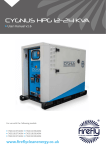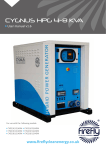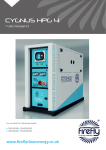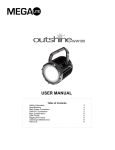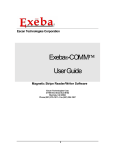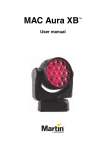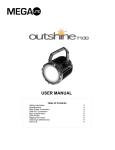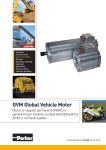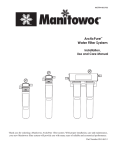Download Cygnus HPG One User Manual
Transcript
CYGNUS HPG 1.2-3.5 KVA User manual v1.6 For use with the following models: CYG1/1.2/6/AGM CYG1/2.4/6/AGM CYG1/3.5/6/AGM www.fireflycleanenergy.co.uk TABLE OF CONTENTS 1 Introduction 1.1 Foreword 1.2 Conventions 1.3 Warnings 1.4 Standards & Regulations 1.5 Disposal & Recycling 1.6 Firefly Contact Details 1.7 About Firefly 4 4 4 5 6 6 6 7 2 Getting Started 2.1 Storage 2.2 Transporting, Lifting & Positioning 2.2.1 Transportation 2.2.2 Lifting (Loading/Unloading) 2.2.3 Positioning 2.3 The Cygnus HPG Control Panel 2.4 Connecting Cygnus HPG 2.4.1 Earth attachment: Installing an Earth Rod 2.4.2 Input Options 2.4.3 Connect The AC Input 2.4.4 Connect The AC Output 8 8 8 8 8 9 10 12 12 13 13 14 3 General Operation 3.1 Turning The Power On 3.1.1 Switching On The Cygnus HPG 3.1.2 Monitoring Battery Bank State of Charge 3.1.3 Emergency Stop Button 3.1.4 Turning Off The Cygnus HPG 3.2 Charging From An AC Supply 3.3 Care And Maintenance 3.3.1 General Cleaning 3.3.2 Caring For The Battery Bank 3.3.3 Testing Cygnus HPG 3.4 Troubleshooting 16 16 16 16 17 18 18 18 19 19 19 19 Page 2 CYGHPG1.2-3.5-User-Manual-V1.6 TABLE OF CONTENTS 4 Appendices 4.1 Connecting To A Fuel Generator For Automatic Stop/Start 4.1.1 Control Panel Auxiliary Connections 4.1.2 Bus Bar Auxiliary Connection 4.2 Earthing Cygnus HPG 4.2.1 When Used Inline With A Secondary Power Source 4.2.2 When Used As A Standalone Power Source 4.2.3 When Charging A Standalone Generator from An AC Source 4.3 System Settings 4.4 Technical Data 21 21 21 21 22 22 22 22 23 25 FIGURES Fig. 1 - Control Panel Fig. 2 - Circuit Breakers Fig. 3 - Earth Point Fig. 4 - Earth Rod Fig. 5 - 5 mm Double Barb Key Fig. 6 - Bus Bar: AC In, AC Out & Auxiliary Fig. 7 - Neutrik powerCON TRUE1 NAC3MX-W Connector Fig. 8 - Neutrik powerCON TRUE1 Socket Fig. 9 - The RCC-03 Battery Monitor Screen Fig. 10 - Auxiliary Bus Bar 10 11 12 12 14 14 15 15 17 21 CYGHPG1.2-3.5-User-Manual-V1.6 Page 3 1 INTRODUCTION 1.1 Foreword Firefly takes this opportunity to congratulate you on receiving your new Cygnus HPG. Designed and manufactured within the United Kingdom using only the finest European sourced electrical components, your new Cygnus HPG offers sustainable power generation with the reliability that you demand. The purpose of this manual is to introduce you to Cygnus HPG and provide you with a guide to its safe installation and operation. This manual describes how your Cygnus HPG works, will help you with fault finding and examines what key components are doing and why. 1.2 Conventions Throughout this user manual the following symbols are used: WARNING This symbol warns of the presence of a dangerous voltage which could cause harm to the operator or others. This symbol indicates the potential of damage to the unit or connected devices. This symbol indicates important or useful information. Page 4 CYGHPG1.2-3.5-User-Manual-V1.6 The following terms are used in this manual to provide greater clarity: • Firefly will be referred to as “The manufacturer”. • The Cygnus HPG Hybrid Power Generator will be referred to as “Cygnus HPG” or “Unit”. • Any items that consume power will be referred to as “Consumers”. 1.3 Warnings This user manual is an important part of Cygnus HPG. It must be kept available to all operators and kept close to the unit so that it can be referred to at any time. WARNING When the unit is operating it generates potentially lethal voltages. Work must only be performed on the unit by the manufacturer or a qualified service engineer approved by the manufacturer. All items connected to the unit including distribution cables and boxes should be regularly checked and adhere to the same local regulations and standards as a regular grid-tied mains installation. CYGHPG1.2-3.5-User-Manual-V1.6 Page 5 1.4 Standards & Regulations Cygnus HPG conforms to the following standards and regulations: • Manufactured in compliance with ISO 9001:2008 • LVD 2006/95/EEC: EN 50178:1197, EN 62040-1:2008 • EMC Directive 2004/108/EC: EN 61000-6-2:2005, EN 61000-6-3:2007, EN 61000-3-2:2006, EN 61000-3-12:2005, EN 62040-2:2006 • IP44 • WEEE Directive 1.5 Disposal & Recycling Cygnus HPG comprises of components that must be disposed of responsibly. For the sake of the environment many of the components within the unit can be recycled or reused. Firefly will ensure the safe decommissioning and recycling of the unit at no charge if the unit is returned to the manufacturer. Otherwise, please contact the manufacturer for more information on safe and proper decommissioning of your Cygnus HPG. 1.6 Firefly Contact Details Firefly Solar Generators Ltd Unit 20 Cliffe Industrial Estate South Street Lewes East Sussex BN8 6JL United Kingdom Page 6 Tel: +44 (0) 1273 40 95 95 Fax: +44 (0) 1273 40 95 96 E-mail: [email protected] Web: www.fireflycleanenergy.co.uk CYGHPG1.2-3.5-User-Manual-V1.6 1.7 About Firefly Firefly is the market leading expert in the design and manufacture of off-grid, portable Hybrid Power Solutions for temporary and permanent power applications. Firefly has built its highly regarded reputation within the industry, based on excellent customer service and product reliability. Founded in 2007 the Company continues to develop innovative solutions to cater to the needs of its ever growing customer sectors. The Company offers green energy products and services that meet the needs of environmentally concerned individuals and organisations internationally, that are looking to reduce their carbon emissions caused by the use of fossil fuels and diesel powered equipment. The unique range of renewable technology solutions produce zero emissions, are truly silent running and eliminate the need for fuel. The systems are manufactured in the UK, under an ISO 9001:2008 approved quality control system. Component suppliers are carefully selected to ensure high levels of reliability and performance of the final product. Installation and stringent testing is carried out to ensure compliance with EU and local legislation where applicable. CYGHPG1.2-3.5-User-Manual-V1.6 Page 7 2 GETTING STARTED 2.1 Storage 1. Cygnus HPG is designed to be used and stored outside. However, to prevent unnecessary weathering it is recommended that the unit is stored inside when possible. 2. It is recommended that the battery bank is charged regularly while in storage. Refer to "3.2 Charging From An AC Supply" on page 18 for further information. 3. The emergency stop should be engaged (pushed in) and output protection switches should be switched off when in storage and not being charged to prevent unnecessary discharge of the battery bank. 2.2 Transporting, Lifting & Positioning This unit is considerably heavier than regular fuel powered generators of similar physical dimensions. Be sure to double check the capacity of lifting equipment. 2.2.1 Transportation 1. Cygnus HPG can be transported using a vehicle with adequate available payload. Check the relevant transportation documentation for suitability. 2. The gross weight of the unit can be found on the rating plate positioned on the left hand side of the unit. 3. It is recommended that the unit is secured using suitable straps when in transit to prevent it from moving. 2.2.2 Lifting (Loading/Unloading) 1. Cygnus HPG must be loaded or unloaded using the correct equipment operated by suitably trained personnel. 2. Using the fork pockets, Cygnus HPG can be loaded or unloaded with a suitable fork-lift truck. 3. The unit can be manoeuvred using a palette truck. Page 8 CYGHPG1.2-3.5-User-Manual-V1.6 Refer to lifting equipment’s operation manual for lifting capacity and manufacturer’s operating instructions. Always check the rating plate to ascertain the gross weight of the unit. The unit must remain upright at all times. 2.2.3 Positioning 1. The unit must be positioned upright on a flat, solid surface. Ensure that the unit is not at risk from being submersed in water above the fork pockets. 2. The unit should be positioned as close as possible to the chosen input source (e.g. Biodiesel generator set, solar array) and where necessary, close to its earth point. 3. Ensure adequate space is allowed for ventilation on all sides and that vents are not obstructed. CYGHPG1.2-3.5-User-Manual-V1.6 Page 9 2.3 The Cygnus HPG Control Panel 5 1 6 2 7 3 8 9 4 Fig. 1 - Control Panel Page 10 CYGHPG1.2-3.5-User-Manual-V1.6 1. 2. 3. 4. 5. 6. 7. 8. 9. Power Switches- Switches the unit on or off Circuit Breakers- See "Fig. 2 - Circuit Breakers" Solar Array Inputs§- 30 A MC3 connections for solar arrays Bus Bar Entry- Provides entry for hard wired auxiliary signal cable, AC input and AC output connections. RCC-03- Provides status and control of the unit’s inverters and charge controller§ Emergency Stop- Press in to immediately halt all operation Auxiliary connection (Generator start)- Provides signals for various applications including the control of an external Generator Set. AC Input Connector- 230 V AC single phase 32 A CEE Form plug AC Output Connector- 230 V AC single phase 32 A CEE Form socket 1 2 3 4 Fig. 2 - Circuit Breakers 1. Solar Isolators§2. Input MCB (Miniature Circuit Breaker)- Overcurrent protection for the 32 A CEE Form and AC Bus Bar inputs 3. Auxiliary Output MCB (Miniature Circuit Breaker)- Overcurrent protection for the rear mounted 16 A powerCON TRUE1 output 4. Output RCBO (Residual Current Circuit Breaker with Overcurrent Protection)- Earth leakage protection for all outputs and overcurrent protection for the 32 A CEE Form and AC Bus Bar outputs Solar inputs, charge controller and solar isolators only available on models with Solar Prep option § CYGHPG1.2-3.5-User-Manual-V1.6 Page 11 2.4 Connecting Cygnus HPG WARNING When using as a standalone power source, a protective earth must be connected to the unit in compliance with applicable local standards and regulations. This can be done either by connecting to a suitable existing electrical earth, or by using an earth rod accessory available from the manufacturer. Refer to "4.2 Earthing Cygnus HPG" on page 22 for further information. 2.4.1 Earth attachment: Installing an Earth Rod 1. The Earth Point of Cygnus HPG is an M10 threaded stud with washers and wing nut located on the skid to the right side of the unit. 2. Find a suitable place to drive the earth rod into the ground. The earth rod should be driven down at least half way into the ground using a mallet and placed as near to the unit as possible. 3. Check the earth cable is securely clamped to the rod. The clamp may need re-tightening after driving the earth rod down. 4. Undo the wing nut from the unit’s earth bolt and remove one of the washers. Then slide the ring terminal at the end of the earth cable onto the earth bolt. Replace the washer and securely tighten the nut. Refer to "Fig. 3 - Earth Point" Fig. 3 - Earth Point Page 12 CYGHPG1.2-3.5-User-Manual-V1.6 Fig. 4 - Earth Rod WARNING Care must be taken to ensure that the correct connections are made to avoid the risk of electrocution or possible damage to the unit’s internal components. Ensure that the cumulative power of connected consumers does not exceed the maximum power output of your unit. Refer to the rating plate to ascertain the unit’s maximum power output. All connected cables, distribution and consumers must be fit for purpose– refer to the consumers’ rating plates and manuals to ascertain the required input. 2.4.2 Input Options The unit can accept inputs from an AC power source (Further information on connecting these items is available in section "3.2 Charging From An AC Supply" on page 18) and/or solar arrays using the optional Solar Prep kit. 2.4.3 Connect The AC Input 2.4.3.1 Connecting with CEE Form Industrial Plug The AC input current is adjustable, allowing the unit to be charged from AC sources with lower current capacities. 1. Ensure that the AC supply being connected to the unit is switched off. 2. Ensure that Cygnus HPG is switched off. See "3.1.4 Turning Off The Cygnus HPG" on page 18 3. Ensure the input breaker is switched off. See "Fig. 2 - Circuit Breakers" Contact the manufacturer for on page 11 further information. 4. Ensure that the CEE Form connectors are dry; wipe off any excess moisture with an absorbent cloth. 5. Insert the 230 V AC supply’s 32 A CEE Form industrial socket into the AC Input plug. See "Fig. 1 - Control Panel" on page 10 6. Switch on the AC input’s power supply. See "3.1.1 Switching On The Cygnus HPG" on page 16 7. Switch on the unit’s input breaker. CYGHPG1.2-3.5-User-Manual-V1.6 Page 13 2.4.3.2 Connecting by Hard Wiring into the AC Input Bus Bar 1. Ensure that the AC supply being connected to the unit is switched off. 2. Ensure that the input breakers are switched down into the off position. See "Fig. 2 - Circuit Breakers" on page 11 3. Ensure that Cygnus HPG is switched off. See "3.1.4 Turning Off The Cygnus HPG" on page 18 4. Open the main door by unlocking the two locks located at its right hand side using the provided 5 mm double barb key See "Fig. 5 - 5 mm Double Barb Key". 5. The Bus Bar is located to the left. 6. Pass the cables through the rubber flap in the door and locate the lower row of connections of the Input section of the AC Bus Bar. 7. Remove the 10 mm nuts. 8. Attach the cables using 6 mm ring terminals. The input and output Bus Bars share the Earth terminal. 9. Replace and tighten the 10 mm nuts. Fig. 5 - 5 mm Double Barb Key 2.4.4 Connect The AC Output There are three options for connecting to the unit's AC output: 32 A CEE Form connector on the front panel, AC Output Bus Bar located behind the front panel door and panel mounted powerCON TRUE1 socket at unit's the rear. 2.4.4.1 Connecting with CEE Form Industrial Plug 1. Before any power connections are made, ensure that Cygnus HPG is switched off. See "3.1.4 Turning Off The Cygnus HPG" on page 18 2. Ensure that the output breakers are switched down into the off position. See "Fig. 2 - Circuit Breakers" on page 11 3. Ensure that the CEE Form connectors to be used are dry; wipe off any excess moisture with an absorbent cloth. 4. Plug the electrical consumers in to the 230 V AC Out CEE Form socket. 5. Switch on the unit. See "3.1.1 Switching On The Cygnus HPG" on page 16 Page 14 CYGHPG1.2-3.5-User-Manual-V1.6 Fig. 6 - Bus Bar: AC In, AC Out & Auxiliary 2.4.4.2 Connecting with 16 A powerCON TRUE1 Plug 1. Consumer(s) to be connected should be fitted with a 16 A powerCON TRUE1 connector. See "Fig. 7 - Neutrik powerCON TRUE1 NAC3MX-W Connector" 2. Before any power connections are made, ensure that Cygnus HPG is switched off. See "3.1.4 Turning Off The Cygnus HPG" on page 18 3. Lift the weatherproof cover from the bottom edge to open it. 4. Ensure that the output breakers are switched down into the off position. See "Fig. 2 - Circuit Breakers" on page 11 5. Ensure that the powerCON TRUE1 connectors to be used are dry; wipe off any excess moisture with an absorbent cloth. 6. Plug the electrical consumers in to the 230 V AC Out powerCON TRUE1 socket. The plug should be inserted and rotated until a click is heard. 7. Ensure that the plug is secure (it will be necessary to slide the sprung catch to remove the plug if it is secured correctly). 8. Switch on the unit. See "3.1.1 Switching On The Cygnus HPG" on page 16 Fig. 7 - Neutrik powerCON TRUE1 NAC3MX-W Connector The powerCON True1 connection's output can be programmed to be automatically switched for applications such as dusk to dawn lighting. Please contact the manufacturer for further information. 2.4.4.3 Connecting by Hard Wiring Into the AC Output Bus Bar 1. Before any power connections are made, ensure that Cygnus HPG is switched off. See "3.1.4 Turning Off The Cygnus HPG" on page 18 2. Open the main door by unlocking the two locks located at its right hand side using the provided 5 mm double barb key. See "Fig. 5 - 5 mm Double Barb Key" on page 14 3. The Bus Bar is located at the bottom left corner. 4. Pass the cables through the rubber flap in the door and locate the lower row of connections of the Output section of the AC Bus Bar. 5. Remove the 10 mm nuts. 6. Attach the cables using 6 mm ring terminals. 7. Replace and tighten the 10 mm nuts. Fig. 8 - Neutrik powerCON TRUE1 8. Switch on the unit. See "3.1.1 Switching On The Cygnus HPG" on page Socket 16 CYGHPG1.2-3.5-User-Manual-V1.6 Page 15 3 GENERAL OPERATION 3.1 Turning The Power On Once all connections are complete, the AC Output of the unit is ready to be switched on. 3.1.1 Switching On The Cygnus HPG 1. Ensure that all connections have been made securely and correct safety procedures followed. 2. Ensure that the Emergency stop button is released by rotating it clockwise. 3. Switch on the output breakers by switching up into the on position. 4. Press the On button. 5. The RCC-03 display will illuminate, indicating that the system is ready to supply power. 3.1.2 Monitoring Battery Bank State of Charge The status of the unit’s internal battery bank is monitored using the RCC-03’s controls. To access the controls: 1. The RCC-03 will initially be in standby mode. Pressing any button will illuminate the display and prepare it for input 2. Press the down arrow once to access the main Battery Monitor screen 3. See "Fig. 9 - The RCC-03 Battery Monitor Screen" for a description of the available information. Page 16 CYGHPG1.2-3.5-User-Manual-V1.6 3 4 5 6 1 2 1 2 3 4 5 6 During Charging During Discharging SoC quick overview Arrows point up indicating Arrows point down indicating direction of current direction of current Voltage of internal battery bank Power being used to charge Power being consumed the battery bank SoC Percentage value Estimated time to 100% SoC Estimated runtime at present power draw Fig. 9 - The RCC-03 Battery Monitor Screen 3.1.3 Emergency Stop Button 1. If there is an emergency or a reason to immediately stop all power from the unit, depress the Emergency Stop Button (Fig. 1, 2) on the Control Panel. 2. The unit will then shut down. Cygnus HPG can not be switched on again until the Emergency Stop Button is released by twisting the red part of the button clockwise. 3. Once the problem has been rectified, follow the instructions in "3.1 Turning The Power On" on page 16 to switch the power back on. CYGHPG1.2-3.5-User-Manual-V1.6 Page 17 3.1.4 Turning Off The Cygnus HPG 4. Select the Off button- see "Fig. 1 - Control Panel" on page 10 5. The RCC-03 screen will turn off, indicating that the unit is off. The unit’s internal cooling system may continue to operate when the unit is in the Off mode Disconnecting Cygnus HPG 1. Ensure that Cygnus HPG is turned off "3.1.4 Turning Off The Cygnus HPG" on page 18 2. Switch off all breakers by pushing the switches down- see "Fig. 2 Circuit Breakers" on page 11 3. Disconnect any input cables. 4. Disconnect any output cables. 5. Remove the earth cable by unscrewing the Earth Point wing nut- see "Fig. 3 - Earth Point" on page 12 6. Replace the washer and wing nut onto the Earth Point bolt. 3.2 Charging From An AC Supply The unit can be charged via a 220 - 240 V AC supply from either the AC grid supply or a secondary power system. To connect an AC supply to Cygnus HPG: 1. Connect the AC Input (See "4.1 Connecting To A Fuel Generator For Automatic Stop/Start" on page 21)- Input LEDs will confirm the presence of the input. 2. Switch on the unit. See "3.1.1 Switching On The Cygnus HPG" on page 16 3. View the Battery Monitor display to confirm that the battery bank is charging and for detailed status (see "3.1.2 Monitoring Battery Bank State of Charge" on page 16) 3.3 Care And Maintenance Page 18 CYGHPG1.2-3.5-User-Manual-V1.6 The unit can be used while chargingthe power automatically passes through to consumers as required. Charging time will increase when consumers are using available input current The input is factory set to accept a 32 A input. It is possible to adjust the unit to accept inputs with lower input currents. 3.3.1 General Cleaning 1. Ensure that Cygnus HPG is switched off. See "3.1.4 Turning Off The Cygnus HPG" on page 18 2. Minor cleaning should be performed using a damp microfibre cloth. 3. Detergents or chemicals should not be used. WARNING Do not use a hose or pressure washer to clean Cygnus HPG 3.3.2 Caring For The Battery Bank The Cygnus HPG battery bank uses sealed, maintenance free batteries. The only routine care necessary is to ensure that when not in use, the unit is charged at least once a month to keep the battery bank topped up. Refer to "3.2 Charging From An AC Supply" on page 18 for further information. Leaving Cygnus HPG in a state of discharge for extended periods will seriously affect its performance. 3.3.3 Testing Cygnus HPG It is recommend that the unit should be tested annually for electrical safety by a qualified electrician. Local regulations may require more frequent testing. Please refer to local regulations for further details. WARNING If Cygnus HPG fails the relevant tests, do not use or open the unit. It must only be opened by a qualified service engineer. It is recommended that a full service is performed every two years in order to ascertain the condition of your system. Please contact the manufacturer for further information. 3.4 Troubleshooting CYGHPG1.2-3.5-User-Manual-V1.6 Page 19 Issue Possible Cause(s) Suggestion Power is on at the Cygnus HPG but the consumers are not receiving any power The output MCB/RCD may not be switched on Check that the MCB/RCD is pushed up to the on position. The system power has been switched on with the On button but there is no display on the RCC-03 The emergency switch may be depressed Twist the red part of the emergency switch clockwise to release. There is power being sent to Cygnus HPG but it is not charging or passing through power The input MCB may not be switched on Check the input MCB is pushed up to the on position Output voltage is lower than 220 V AC over distance If the distance between the unit and the consumers is more than 50 m the voltage can drop too low. The voltage setting should be adjusted using the RCC-03. Contact the manufacturer for further instructions. “Battery Voltage Too Low” Message on RCC-03 This indicates that the battery bank voltage has reached its lower limit Charge Cygnus HPG from your chosen renewable power source, from an AC grid connection or secondary power system An RCD continually trips There is an electrical fault with the power distribution circuit or consumers connected to the relevant AC output Check the electrical integrity of the power distribution circuit and consumers being connected to the unit The MCB continually trips The consumers being connected draw too much power for the rated output of the unit Refer to the maximum output rating on the unit’s rating plate and reduce the total power draw accordingly. Generator auto start not working Auxiliary signal cable is loose or has been damaged Reattach or replace the auxiliary cable. A Solar Array is connected to the Solar Array inputs but the Control Centre’s Solar Charge indicator does not illuminate Page 20 The system has not been switched on The Solar Isolator is in the off position CYGHPG1.2-3.5-User-Manual-V1.6 Ensure that the system is switched on and that the relevant isolator(s) are in the on position. 4 APPENDICES 4.1 Connecting To A Fuel Generator For Automatic Stop/Start Auxiliary connections are provided which allow the automatic control of a fuel powered generator. These allow Cygnus HPG to control the start up and shut down of the attached generator under pre-programmed conditions using the RCC-03. 4.1.1 Control Panel Auxiliary Connections An auxiliary connector is provided on Cygnus HPG’s main control panel. See "Fig. 1 - Control Panel" on page 10, item 3. It is factory set to allow control of a secondary power source such as a biofuel generator. An auxiliary connecting cable is available from the manufacturer as an accessory. Only the yellow, green & red connections are used as follows: Wire Colour Red Yellow Green Blue WARNING When using Cygnus HPG with a fuel powered generator, do not connect the Cygnus HPG generator’s earth. The earth from the fuel powered generator is passed through to Cygnus HPG. Connection Normally Closed Common Normally Open Not Used 4.1.2 Bus Bar Auxiliary Connection Screw terminal connections are also provided behind the rubber flap at the bottom left of the main control panel door. These are alternative connections for the same auxiliary channel as the control panel mounted connector. Terminal Number 1 2 3 Connection Aux. 1 Normally Closed Aux. 1 Common Aux. 1 Normally Open The wires are pushed into the terminals from the top. Tighten in place with the screws along the top front edge, using a small flat screwdriver. Fig. 10 - Auxiliary Bus Bar CYGHPG1.2-3.5-User-Manual-V1.6 Page 21 4.2 Earthing Cygnus HPG 4.2.1 When Used Inline With A Secondary Power Source When Cygnus HPG is being used inline with a secondary power source such as a fuel powered generator, Cygnus HPG should not be connected to earth directly with its own earth connection. The secondary power source should be earthed and the Cygnus HPG's earth connection will be made through the Bus Bar or CEE Form connection. This ensures that any earth leakage is detected and managed correctly by the secondary power source. 4.2.2 When Used As A Standalone Power Source When used as a standalone generator, either powered solely from the internal battery bank or when receiving input from a solar array using the optional Solar Prep., Cygnus HPG should be connected to earth. This can be facilitated either by use of an earth rod (see "4.2 Earthing Cygnus HPG" on page 22) or connecting to a suitable existing earth point. 4.2.3 When Charging A Standalone Generator from An AC Source While a standalone Cygnus HPG is being charged from a secondary power source such as a fuel powered generator or grid connection which will be disconnected once the unit is charged, it is not necessary to disconnect the Cygnus HPG's earth connection. WARNING When using as a standalone power source, a protective earth must be connected to the unit in compliance with applicable local standards and regulations. This can be done either by connecting to a suitable existing electrical earth, or by using an earth rod available from the manufacturer as an accessory. Page 22 CYGHPG1.2-3.5-User-Manual-V1.6 4.3 System Settings WARNING The AC Output Voltage and System Earthing parameters must only be changed by a competent electrical engineer. The following settings are available to users through the RCC-03 controls. Further details available on request. Basic Settings Maximum current of AC Source Restore default settings Min: 2 Default: 50 Max: 50 Yes -> Confirm Inverter Min: 220 V AC Output Voltage Danger! Adjustments should only be Default: 230 V Max: 245 V made by qualified personnel § AC In & Transfer Maximum current of AC Source Min: 2 Default: 50 Max: 50 Aux. Contact 1 Operating Mode Automatic (Default) Reverse Automatic Manual On Manual Off Combination of Events Any (Default) And Contact active with fixed time schedule AC In & Transfer Current settings provide adjustment to allow charging sources with various capacities to be used with the unit. § CYGHPG1.2-3.5-User-Manual-V1.6 Page 23 Program 1 Day of week Start hour End hour Contact active on event Yes No Xtender is off For info only Contact active with inverter power or smart boost Inverter power level 1 activate Default: Yes No Power level 1 (% pNom) Min: 20 Default: 80 Max: 120 Time delay (minutes) Min: 0 Default: 0 Max: 60 Inverter power level to deactivate (% Min: 20 pNom) Default: 70 Max: 120 Time delay to deactivate (minutes) Min: 0 Default: 60 Max: 60 Contact active according to SoC Contact activated with SoC 1 No Yes (Default) Contact deactivated over SoC (minutes) Min: 20 Default: 60 Max: 100 Page 24 CYGHPG1.2-3.5-User-Manual-V1.6 System Remote entry On/Off Auto restarts After battery undervoltage For info only No Yes (Default) After inverter or Smart Boost overload No Yes (Default) Delay to restart after overload (seconds) Min: 2 Default: 20 Max: 60 System Earthing (Earth-Neutral) - Danger! Adjustments should only be made by qualified personnel Prohibited ground relay No (Default) Yes Continuous neutral No (Default) Yes RCC Settings Language English French German Spanish Time Date Unlock code requiredUser Level available from the manufacturer on request. Save & Restore Files Save all files (system backup) Set & Confirm Restore all files (system recovery) Set & Confirm Apply configuration files (load master Set & Confirm file from SD card) Extended and Special Functions Advanced options for service engineers only CYGHPG1.2-3.5-User-Manual-V1.6 Page 25 Cygnus® One HPG Technical Data Sheet (AGM) Model1 CYG1/1.2/6/AGM CYG1/2.4/6/AGM CYG1/3.5/6/AGM Prime Power Rating @ 25°C (kVA) 0.8 2 3 Standby Power Rating @ 25°C - 30 mins (kVA) 1.2 2.4 3.5 Surge Power Rating @ 25°C - 5 secs (kVA) 2.5 6 9 AC Output Voltage - 50 Hz (V) 230 (Adjustable) AC Input Current Max (A) 16 AC Output Current Max (A) 20 32 32 Transfer Relay Time (ms) Standby Power Consumption (W) Inverter Protection < 15 1.5 1.6 Overload, Overheat, Short Circuit, Low Battery & Battery Reverse Polarity Battery Storage Type AGM (Sealed Lead Acid) Battery Capacity @ 25°C, C20, 70% DoD2 (kWh) Earth Fault Protection 6 20 A 30 mA RCBO Power Input Connections 1 x 32 A CEE Form, AC in Busbar Power Output Connections Auxiliary Connection (Remote Generator Start) Battery Monitoring 1 x 32 A CEE Form, AC Out Busbar, Powercon True 16 A Buccaneer Mini400 4pin (1 x Auxiliary 2 wire contacts NO & and NC, fully programmable) & internal Auxiliary Busbar LCD Display with Voltage Indicator, Power Input / Output, Time Available, Charge State History and Battery Management Available Menu Languages Charge Time Using 32 A Inlet3 (hours) 32 A 30 mA RCBO English, French, Spanish, German 14 6.5 Water/Ingress Protection Rating IP54 Operating Temperature Range4 (°C) Weight (kg) Dimensions W x D x H (mm) 6 -20 to +45 340 346 350 675 x 1020 x 717 Fork Pocket Dimensions W x D x H (mm) 200 x 675 x 97 Distance Between Fork Pockets (mm) 250 Solar Preparation Upgrade Package5 MPPT Solar Charge Controller With Up To 2.5 kWp Array Connection Remote Communication and Data Collection Package Integrated GSM Modem To Collect System Status, Live & Historic Data, Fault & Event Notification, System Control & Programming 1 Units with solar preparation option have /S suffix 2 kWh is based on C20 rate and will vary depending on rate of discharge (see Fig. 2 & Fig. 5) 3 Charge time dependent on availale current of external source Battery bank capacity may be affected by charging or discharging at less than 0°C (see Fig. 4) 4 Battery bank total cycle life may be affected by charging or discharging in excess of 25°C (see Fig. 3) 5 Optional upgrade available pre or post purchase of main unit This document was updated July 2015. While every effort has been made to ensure accuracy, no responsibility can be accepted for errors or omissions. Data may change, as well as legislation, and you are strongly advised to obtain copies of the most recently issued regulations, standards and guidelines. This document is not intended to form the basis of a contract. Firefly has a policy of continuous product improvement and reserves the right to change specifications without notice.©2015 Firefly . All rights reserved. Firefly - Clean Energy, Unit 20, Cliffe Industrial Estate, South Street, Lewes, BN8 6JL, UK T: +44 (0)1273 40 95 95 F: +44 (0)1273 40 95 96 W: www.fireflycleanenergy.co.uk E: [email protected] Firefly_Cygnus_One_HPG_AGM_TDS_v2.2 - 29 July 2015 11:41 AM Cygnus® One HPG Technical Data Sheet (AGM) Total System Load 25 2500 20 2000 7 6 5 15 1500 1000 500 4 3 10 2 5 0 20 60 40 80 100 0 Depth of Discharge (%) 1 0.3 0.5 1 Load (kVA) 2 3 Runtime (Hours) Battery Bank Capacity (kWh) Fig. 1 Fig. 2 Temperature Vs Battery Cycle Life Temperature Vs Storage Capacity 120 80 Capacity (%) Derating (%) 100 60 40 20 0 20 30 40 Temperature (°C) 100 80 60 -35 50 Fig. 3 -15 5 Fig. 4 Runtime & Capacity Vs Total System Load Runtime (hours) Available Storage (kWh) Current (A) Power (kVA) 20 18 16 14 12 10 9 8 7 6 5 4 3 2 1.5 6.2 6.0 5.9 5.7 5.5 5.5 5.3 5.2 5.1 5.0 4.9 4.6 4.4 4.2 3.9 1.4 1.5 1.6 1.8 2.0 2.4 2.6 2.8 3.2 3.6 4.2 5.0 6.3 9.1 12.3 0.3 0.3 0.4 0.4 0.5 0.5 0.6 0.6 0.7 0.8 1.0 1.1 1.5 2.1 2.8 Fig. 5 Firefly - Clean Energy, Unit 20, Cliffe Industrial Estate, South Street, Lewes, BN8 6JL, UK T: +44 (0)1273 40 95 95 F: +44 (0)1273 40 95 96 W: www.fireflycleanenergy.co.uk E: [email protected] Firefly_Cygnus_One_HPG_AGM_TDS_v2.2 - 29 July 2015 11:41 AM 25 Temperature (°C) 45 0 kWh 3000 Hours No. of Cycles Battery Bank Cycle Life



























